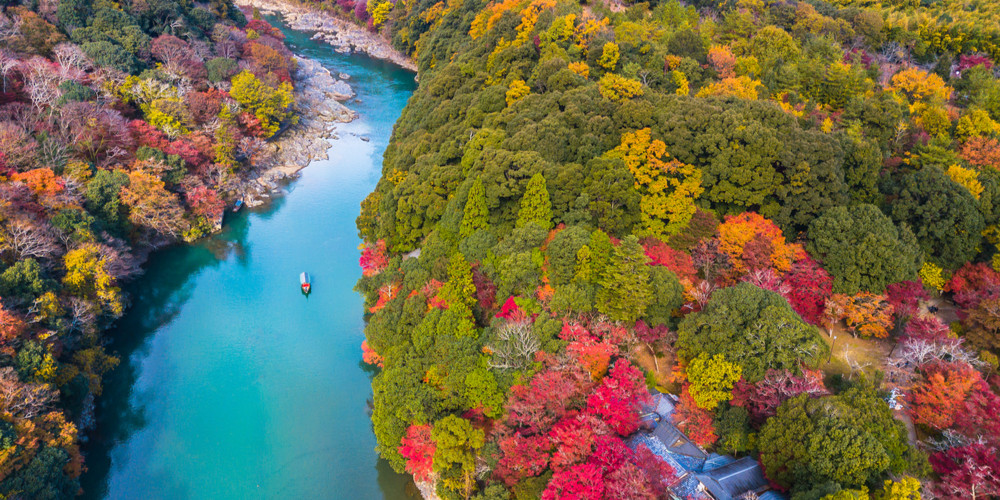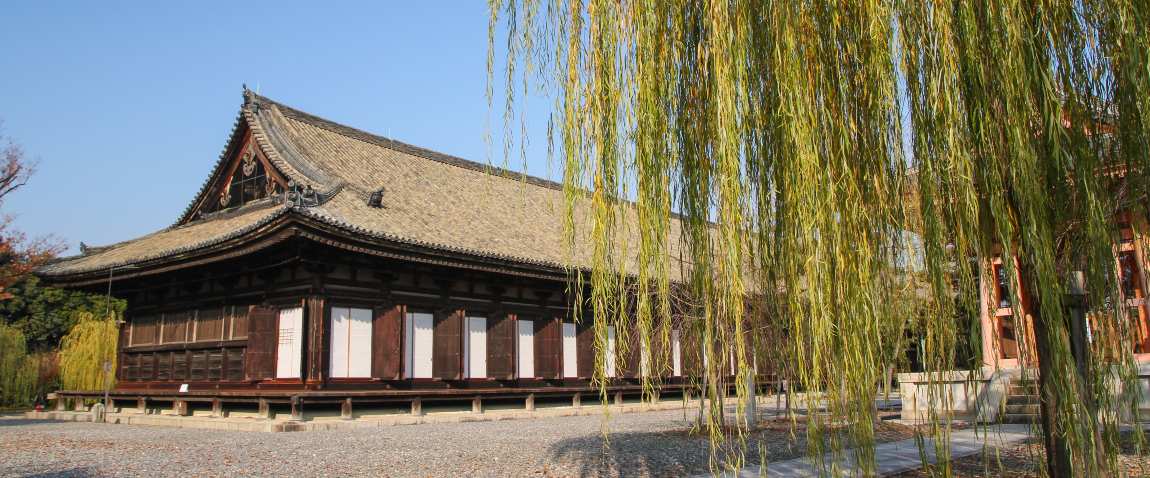
Kyoto is one of Japan's major cities, surrounded by the central Honshu highlands. It is also the educational centre of western Japan, including several universities and higher education institutions. Despite being one of Japan's most popular tourist attractions, it is known for preserving much of the aura of the past, as it was the only major Japanese city to escape WWII's devastation. You will see the top tourist attractions map in Kyoto Japan, throughout this article. Also, keep in mind that you can get all the needed information about visa to Japan on our website's "Services" section.
For almost 1,100 years, Kyoto has been known as the emperor's palace and Japan's primary cultural hub. There are many famous tourist attractions in Kyoto Japan, including visiting its many museums and galleries to see outstanding examples of sculptures, paintings, and other art forms.
Non-touristy places should also be included in your Kyoto trip plan. Numerous elements of its centuries-old architecture, most influenced by Buddhism, may still be seen in the many magnificent temples nestled in the calmer, less frequented parts of the ancient city.
Kyoto continues to play a significant part in Japanese religion, with 30 of the city's temples acting as Buddhist sect headquarters and more than 200 Shinto shrines inside the city boundaries. In total, 17 historic structures in Kyoto have been recognized as UNESCO World Heritage Sites.
Top tourist attractions map in Kyoto Japan:
1. Daitoku-ji Temple

Let's start our tour of famous tourist attractions in Kyoto Japan, with Daitoku-ji Temple. The Daitoku-ji Temple, or Zen Temple of Great Virtue, was founded in 1324 and is one of the Rinzai sect's most important temples. The current buildings were built in the 16th and 17th centuries.
Seven of the 22 structures on the property are available to the public. The Kara-mon, a Chinese-style gate with beautiful carvings, and the Sammon, a two-story main gate erected in 1589 and famous for its numerous excellent ceiling murals and sculptures, are two examples. The Butsuden (or Daiyu-den) was erected in 1664 and had a statue of Shakyamuni with his pupils Anna and Kayo and a statue of Daito-kokushi, the temple's first Abbot.
The Lecture Hall, or Hatto, is based on Chinese patterns, while the Hojo, or Abbot's Lodging, with its paintings, wooden tablet, and surrounding garden, lies beyond the Main Hall.
The old Abbot's Lodging (Shinju-an) sculptures and tombs from the 14th century and a beautiful Zen garden are noteworthy.
2. Fushimi Inari Taisha

The Fushimi-Inari Taisha Shrine is among one of the well-known tourist attractions in Kyoto Japan. The temple, founded in AD 711 and dedicated to Ukanomitama, the goddess of rice-growing, is still visited by merchants and traders who pray for success.
The main structure was built in 1499 and had a four-kilometre-long avenue of vivid orange "torii," or arches, each dedicated by a company (it takes some two hours to travel past the 1,000 arches lining the route). The various statues of foxes said to be messengers of the gods are also noteworthy.
Nighttime is a fantastic time to visit the shrine. You'll be rewarded with not just a unique view of this beautifully lighted heritage landmark but also with few if any, crowds.
Purchase traditional Japanese fortune cookies at the stores and booths near the shrine's entrance to keep you going. Visit as early in the day as possible to avoid the crowd (a 7 am or 8 am start is well worth it for the chance to avoid other visitors).
3. Gion's Geishas and Temples

Gion, Kyoto's entertainment and geisha district, is a great place to go about and explore on foot. On the Kamogawa River's eastern bank, Gion is an eclectic combination of modern architecture and historical beauty that offers a unique flavour of various Japanese customs, from beautifully costumed geishas to well-preserved 17th-century eateries and teahouses that provide a view of old Japan.
Gion is known for its numerous beautiful temples and is centred on Hanami-Koji Street, Shijo-dori Street, and the waterside promenades of Shirakawa Minami-dori Street. The Chion-in Temple and the 15th-century Silver Pavilion (Ginkakuji) are the most well-known of them.
Chion-in is a well-known temple in Japan, known for its 24-meter-high two-story tower (Sammon-san), which contains Japan's biggest bell. It was cast in 1633 and is only rung at festivities in mid-April, weighing 71 tons. Gion is also a great (and safe) spot to go on a nighttime walking tour.
4. Nishi Honganji Temple

Nishi Honganji Temple, the primary temple of the ancient Jodo-shinshu sect, is a magnificent example of Buddhist architecture. The Hondo, or Main Hall, is a must-see. Many chambers adorned with paintings on gold backgrounds and several noteworthy sculptures, some originating from the 6th century, are prominent characteristics of this beautiful tower, which was rebuilt in 1760.
The Founder's Hall is also worth seeing (Daishi-do). Shinran's much-loved statue, sculpted in 1244 and afterwards coated with a layer of lacquer combined with his ashes, may be found here.
The Daishoin, or Treasury, is another remarkable structure, with numerous chambers called for the beautiful wall and ceiling murals that adorn it. The Sparrow Room (Suzume-no-ma), the Room of the Wild Geese (Gan-no-ma), and the Chrysanthemum Room (Kiku-no-ma), all of which include excellent 17th-century paintings of flowers in gold and white by Kaiho Yusetsu, are among them.
The Jodo-shinshu sect's Higashi-Honganji Temple is well worth visiting. It was founded in 1602, and it now houses a collection of excellent art.
5. Rengeoin Sanjusangendo

The Temple of the 33 Niches, also known as Sanjsangen-d (Rengyoin Temple), gets its name from its unique structure: its façade is split into 33 (sanjusan) niches (gen) to symbolize the idea that Kannon, the Goddess of Mercy, could take on 33 different personifications.
After a fire destroyed the previous structure in 1164, the current elongated structure was built in 1266. The numerous arrowhead-made holes in its old pillars and beams attest to its previous prominence as a location of archery instruction.
The Kannon with a Thousand Hands, a roughly three-and-a-half-meter-tall statue, is the most important of its numerous works of art. It dates from the 13th century and is known for the 500 Kannon standing statues that line either side. Behind it, there are other statues of the 28 "celestial auxiliaries," spirits that are regarded subservient to Kannon.
6. Kyoto Imperial Palace
.jpg)
Built in AD 794 and rebuilt many times after being devastated by fire, the original Kyoto Imperial Palace (Kyoto-gosho) is now one of the city's most visited historical monuments. The current structure, which was built in 1855, continues to astonish.
Highlights include its artistically adorned gates and major chambers and structures, housed inside a vast (once-walled) enclosure near the city's core. The Imperial Library, the Emperor's Residence (Seiryo-den), the Courtroom (Ko-gosho), and the Hall for State Ceremonies (Shishinden) are among them.
The beautiful gardens of this Kyoto landmark are available to the public, but the palace itself may only be viewed as part of an Imperial Household Agency-led guided tour. Make reservations and fill out application forms ahead of time by visiting their website.
7. Kiyomizu-dera Temple
.jpg)
We continue the topic related to Kyoto Japan tourist attractions with another temple. The Kiyomizu-dera Temple, an important UNESCO World Heritage Site atop Otowa Mountain overlooking Kyoto, is located in the city's east section. Visitors may take a pleasant journey to the temple via Tea-pot Lane, lined with small shops and artisan businesses.
This lovely temple was built in AD 790 and is devoted to the Buddhist Goddess of Mercy, the 11-headed Kannon, whose statue may be seen here. The current structures, mostly on a rocky outcrop high above the Otowa Waterfall, were built after 1633 during the reign of the third Tokugawa Shogun, Iemitsu.
The Main Hall's enormous terrace, built on 30-meter-tall pillars with five rows of cross-beams and utilized as a platform for temple dances and rituals, is a highlight. The terrace offers breathtaking views of the city and the neighbouring forested hills, especially when the leaves change color in the fall. There are customized English-language guided tours available.
8. Kinkaku-ji: The Golden Pavilion
.jpg)
The beautiful Golden Pavilion (Kinkaku-ji), originally erected in the 14th century as a retirement home for Shogun Ashikaga Yoshimitsu and now a Zen Buddhist temple is a tourist attraction in Kyoto Japan.
The tower has been rebuilt several times in its original shape, the most recent incarnation being from the late 1950s. It gets its name from the gold leaf covering the top two of its three stories, an architectural feature that removes any negative associated with death.
The location, built over a huge pond, is also known for its lovely gardens, an old stone pagoda, and the Sekkatei Teahouse, which serves traditional Japanese drinks. Visit during the winter or autumn to get a new view of this excellent tourist site while also avoiding the summer crowds (the latter is spectacular thanks to the fall colours).
9. Nijo Castle
.jpg)
Nijo Castle (Nij-j) was constructed in 1603 and later served as the seat of administration, with well-preserved walls, turrets, and a moat. The complex consists of many buildings that house many important works of art, and it is well-known as the site where the emperor issued the rescript that ended the country's once-powerful Shogunate.
The East Gate (Higashi Otemon, the castle's principal entrance) and the Inner Gate, or Karamon, are both noteworthy for their exquisite carvings and ornate metalwork. Aside from that, the intricate Mikuruma-yose is a must-see. The beautiful grounds of the castle are worth visiting.
Ninomaru Palace is the most notable structure on the site. It comprises five different buildings connected by corridors and features magnificent interiors with several paintings by Kano Tanyu and his disciples. The Hall of the Imperial Emissary (Jodan-no-ma) is the main apartment, and it is matched in magnificence by the surrounding chambers, Ni-no-ma and Tozamurai-no-ma, with their tiger murals.
With its enormous Audience Hall encircled by a gallery and sliding doors with large paintings of larches on a gold backdrop, the neighbouring structure is well worth seeing. Animal paintings by Kano Naonobu may be seen in the fourth structure, the Kuro-Shoin, while paintings of mountain scenery can be found in the Shogun's private rooms.
If you're on tour, make sure to ask for a chance to walk on the castle's renowned "nightingale floors." These creaking floorboards precisely replicated the chirping of a nightingale.
For information related to Japan visa visit Pickvisa.com. Do not wait to travel with us – Pickvisa!


